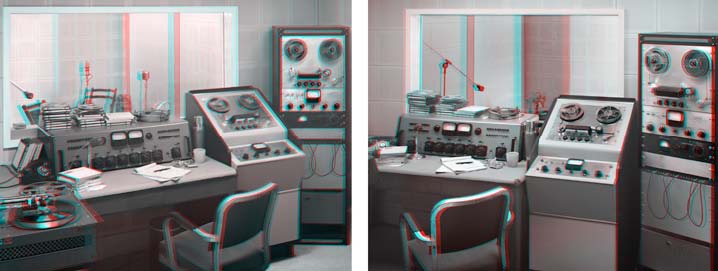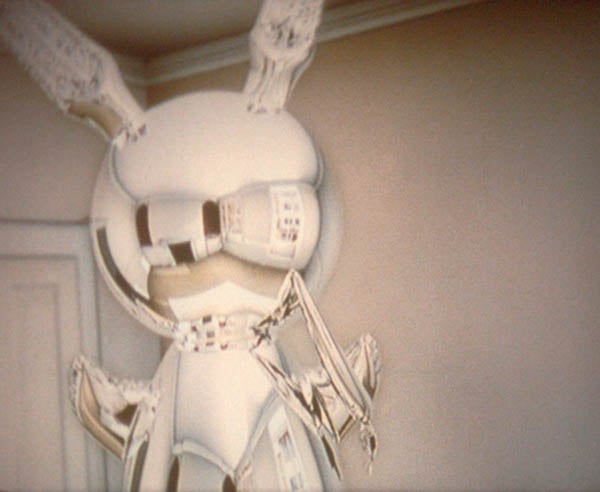
© » KADIST
Mary Reid Kelley
Priapus Agonistes by Mary Reid Kelley and Patrick Kelley is the first work in The Minotaur Trilogy (2013-2015), a trio of videos that reimagine the Greek myth of the Minotaur. The monstrous result of Queen Pasiphae’s infatuation with a bull, the Minotaur lived in a huge maze known as the Labyrinth where he would devour sacrificial offerings of youths and maidens. Traditionally, the story centers on Theseus and his heroic (and successful) quest to conquer the Minotaur, subsequently freeing the people of Athens from their obligations.

© » KADIST
Mary Reid Kelley
In the video The Syphilis of Sisyphus (2011), Reid Kelley transported her heroine to the French demimonde. The film centers on a pregnant Parisian prostitute who exemplifies Baudelaire’s paean to the superiority of cosmetic over natural beauty. With sets that shift between Sisyphus’s boudoir and the streets of Paris, the work is an antic romp through Revolutionary and post Revolutionary France, with brief vignettes involving everyone from Diderot, Marie Antoinette, and Marat to Robespierre, Napoleon, and Haussmann.

© » KADIST
Mary Reid Kelley
Situated in German-occupied Belgium at the end of World War I, Y ou Make Me Iliad by Mary Reid Kelley focuses on the story of two. characters: a Belgian prostitute working near the frontlines and a young German soldier charged with monitoring the brothels. Harboring literary aspirations, the soldier goes in search of material to complete his novel.

© » KADIST
Mary Reid Kelley
Kelley’s 2015 portrait of the poet Charles Baudelaire is one of a series of poets, rappers, and other thinkers who have influenced the artist’s ideas about beauty, creativity, and expression. As a challenging artist who marches to her own drum, Mary Reid Kelley is in the vanguard of a generation that blends the digital and the analog to dialogue with history. From 2009 to the present, she has made videos that fuse live performance, animation, drawing, sculpture, and digital design.

© » KADIST
Kelly Sinnapah Mary
Notebook 10 , l ‘enfance de sanbras (The Childhood of Sanbras) series by Kelly Sinnapah Mary is a sequel to an earlier series by the artist titled Cahier d’un non retour au pays natal (2015). This earlier work considers the process of reconstructing an identity of the Indian workers who arrived in the Caribbean during the post-slavery period. The work addresses the conditions of recruitment of these Indian workers, the strategies of the recruiters, how they lured them onto ships to bring them back to the plantations.

© » KADIST
Kelly Sinnapah Mary
Notebook 10 , l ‘enfance de sanbras (The Childhood of Sanbras) series by Kelly Sinnapah Mary is a sequel to an earlier series by the artist titled Cahier d’un non retour au pays natal (2015). This earlier work considers the process of reconstructing an identity of the Indian workers who arrived in the Caribbean during the post-slavery period. The work addresses the conditions of recruitment of these Indian workers, the strategies of the recruiters, how they lured them onto ships to bring them back to the plantations.

© » KADIST
Kelly Sinnapah Mary
Notebook 10 , l ‘enfance de sanbras (The Childhood of Sanbras) series by Kelly Sinnapah Mary is a sequel to an earlier series by the artist titled Cahier d’un non retour au pays natal (2015). This earlier work considers the process of reconstructing an identity of the Indian workers who arrived in the Caribbean during the post-slavery period. The work addresses the conditions of recruitment of these Indian workers, the strategies of the recruiters, how they lured them onto ships to bring them back to the plantations.

© » KADIST
Kelly Sinnapah Mary
Notebook 10 , l ‘enfance de sanbras (The Childhood of Sanbras) series by Kelly Sinnapah Mary is a sequel to an earlier series by the artist titled Cahier d’un non retour au pays natal (2015). This earlier work considers the process of reconstructing an identity of the Indian workers who arrived in the Caribbean during the post-slavery period. The work addresses the conditions of recruitment of these Indian workers, the strategies of the recruiters, how they lured them onto ships to bring them back to the plantations.

© » KADIST
Kelly Sinnapah Mary
Notebook 10 , l ‘enfance de sanbras (The Childhood of Sanbras) series by Kelly Sinnapah Mary is a sequel to an earlier series by the artist titled Cahier d’un non retour au pays natal (2015). This earlier work considers the process of reconstructing an identity of the Indian workers who arrived in the Caribbean during the post-slavery period. The work addresses the conditions of recruitment of these Indian workers, the strategies of the recruiters, how they lured them onto ships to bring them back to the plantations.

© » KADIST
Kelly Sinnapah Mary
Notebook 10 , l ‘enfance de sanbras (The Childhood of Sanbras) series by Kelly Sinnapah Mary is a sequel to an earlier series by the artist titled Cahier d’un non retour au pays natal (2015). This earlier work considers the process of reconstructing an identity of the Indian workers who arrived in the Caribbean during the post-slavery period. The work addresses the conditions of recruitment of these Indian workers, the strategies of the recruiters, how they lured them onto ships to bring them back to the plantations.

© » KADIST
Kelly Sinnapah Mary
Notebook 10 , l ‘enfance de sanbras (The Childhood of Sanbras) series by Kelly Sinnapah Mary is a sequel to an earlier series by the artist titled Cahier d’un non retour au pays natal (2015). This earlier work considers the process of reconstructing an identity of the Indian workers who arrived in the Caribbean during the post-slavery period. The work addresses the conditions of recruitment of these Indian workers, the strategies of the recruiters, how they lured them onto ships to bring them back to the plantations.
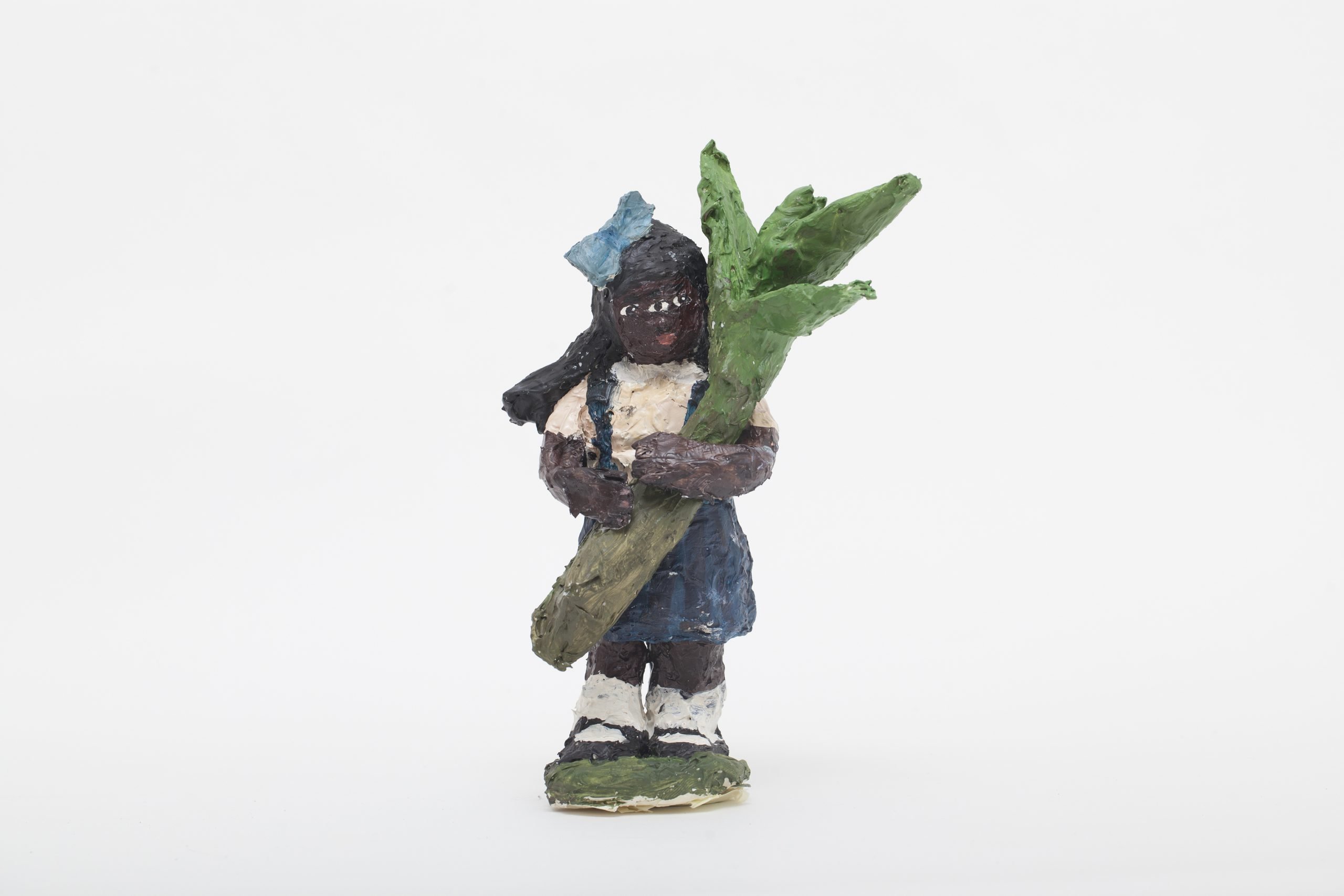
© » KADIST
Kelly Sinnapah Mary
Notebook 10 , l ‘enfance de sanbras (The Childhood of Sanbras) series by Kelly Sinnapah Mary is a sequel to an earlier series by the artist titled Cahier d’un non retour au pays natal (2015). This earlier work considers the process of reconstructing an identity of the Indian workers who arrived in the Caribbean during the post-slavery period. The work addresses the conditions of recruitment of these Indian workers, the strategies of the recruiters, how they lured them onto ships to bring them back to the plantations.

© » KADIST
Kelly Sinnapah Mary
Notebook 10 , l ‘enfance de sanbras (The Childhood of Sanbras) series by Kelly Sinnapah Mary is a sequel to an earlier series by the artist titled Cahier d’un non retour au pays natal (2015). This earlier work considers the process of reconstructing an identity of the Indian workers who arrived in the Caribbean during the post-slavery period. The work addresses the conditions of recruitment of these Indian workers, the strategies of the recruiters, how they lured them onto ships to bring them back to the plantations.

© » KADIST
Kelly Sinnapah Mary
Notebook 10 , l ‘enfance de sanbras (The Childhood of Sanbras) series by Kelly Sinnapah Mary is a sequel to an earlier series by the artist titled Cahier d’un non retour au pays natal (2015). This earlier work considers the process of reconstructing an identity of the Indian workers who arrived in the Caribbean during the post-slavery period. The work addresses the conditions of recruitment of these Indian workers, the strategies of the recruiters, how they lured them onto ships to bring them back to the plantations.

© » KADIST
Mike Kelley
Towhead n’Ganga, enclosed in darkness, lorded over by the sexualized folded high priestless form reflects many of Kelley’s works, in both its compositional and semantic qualities. The drawing on wood, the popcorn mixture, and the title all manifest a bumpy fullness, a “more-is-more” conflation between supposedly eternal spirituality and everyday stuff. The work’s title points to a serious timelessness completely belied by the materials.

© » KADIST
Kelley Walker
The triptych Black Star Press is part of the series ‘The Black Star Press project’ initiated in 2004 by the American artist Kelley Walker. The images in this series are taken from a photo essay on the struggle for civil rights in Alabama, directed by Charles Moore in 1962 (and published by the magazine ‘Life’) which showed the repression of the black population and persistent inequalities in the southern United States. The title “Black Star Press” is taken from the name of the news agency where Charles Moore worked, and it refers to the young black man shot fighting for the rights of his community.

© » KADIST
Christoph Keller
Message to the Extraterrestrials consists of a slide projector beaming images into the side of the telescope. These are then reflected down to a mirror at the bottom of the telescope and from there to a mirror on the ceiling. From the ceiling the images bounce down to a mirror at floor level which projects the images through an open window to the world outside.

© » KADIST
Daniel Keller
To make the video installation Soft Staycation (Gaze Track Edit) , the artist, playing the role of ‘job creator’, hired a group of unemployed and expat freelancers through Craigslist to watch a 30 minute compilation of national tourism ads. These ads, which are generally sponsored by various publicly funded tourism boards and screened in airports for example, were found on the Internet by Keller. He used a gaze-tracking camera to measure the eye movements of the people participating in the experiment.

© » KADIST
Mary Ann Aitken
Untitled (Boom Box, Double-Sided) by Mary Ann Aitken is representational painting of a boom box on an unconventionally long canvas painted on both sides, to mimic the scale and appearance of the actual appliance. Known for going against trends, Aitken often favored dimensions, such as the square, that were otherwise considered out of style in contemporary painting. In this double-sided painting, one side depicts the titular boombox set up—a boxy cassette player, flanked by a pair of stereo speakers in front of wood panelling.

© » KADIST
Mary Ann Aitken
Untitled (Diptych) by Mary Ann Aitken is a pair of paintings; one entirely abstract and the other a hybrid of representational and abstract elements. The left-side painting is a cacaphonous all over composition of brushstrokes layered in the artist’s signature primary colors. In the same color scheme, the right-side painting portrays a still life with an arrangement of flowers as its focal point, with marks and splatter spilling from the left-side composition into the right.
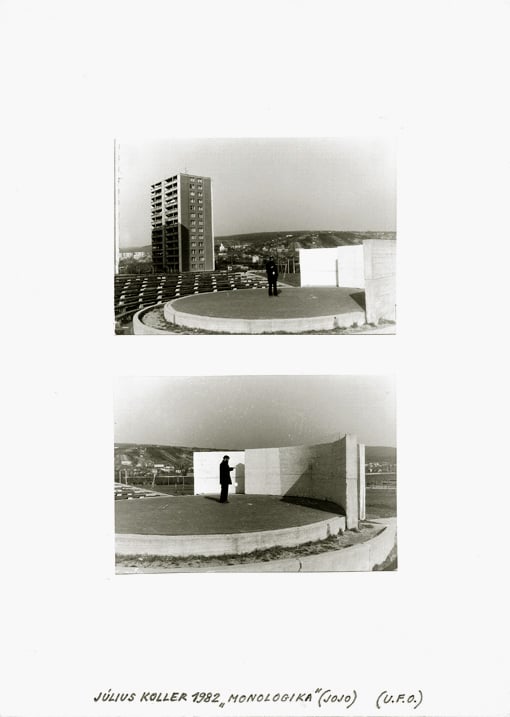
© » KADIST
Julius Koller
The photograph Monologic – Yo-Yo 1, 2 (U. F. O. ), (1982), shows Koller playing with a big white Yo-Yo in a drab concrete building among a group of tower blocks.

© » KADIST
Julius Koller
Drawing & Print (Drawing & Print)
Anti-Happening refers to Koller’s 1965 manifesto, ‘Anti-Happening (System of Subjective Objectivity)’. In opposition to the notion of a ‘happening’ as a way of actualising group identity, in his manifesto, Koller stated that his concept of the ‘anti-happening’ aimed at a ‘cultural reshaping of the subject, at awareness, at the surroundings and the real world’ [i] . Unlike happenings, these actions do not involve the staging of psychologically expressive performances.

© » KADIST
Mary Helena Clark
By testing the limits of identification with the camera’s point of view, Delphi Falls cycles through multiple subjectivities. The film misuses more traditional narrative conventions -the suggestion of a story, the anchoring of actors as characters- to have the viewer constantly questioning who or what they are, and where they are located in the film’s world. Delphi Falls was included in the 2017 Whitney Biennial film program.

© » KADIST
Mary Helena Clark
The Dragon is the Frame by Mary Helena Clark is an elegy that is somewhat paradoxically organized as a film noir or murder mystery, one that pays direct homage to Hitchcock’s Vertigo . But the parts don’t fit, and it is only in the eventual recognition of this faux raccord that Clark’s higher purpose becomes apparent. As we hear Bernard Herrmann’s score, we see the Golden Gate Bridge, Mission Dolores, and other Vertigo locations in the present day.

© » KADIST
Tessa Mars
In this untitled acrylic painting, Tessa Mars explores the long-lasting effects of colonialism on the Afro-Caribbean diaspora, particularly in terms of female vulnerability and resilience. Drawing on her interest in retelling stories of her native country, and confronting the past and the present, Mars portrays her cultural essence and heritage by imagining spiritual spaces that connect people and land across time. With a pictorial practice that highlights pastel colors, the divinisation of the figures on the canvas and the spiritual elements within the composition ultimately enhance the narrative of her Caribbean ancestry while conflating the distinctions between autobiographical and historical events.

© » KADIST
Mark Bradford
Drawing & Print (Drawing & Print)
This untitled work from 2012 is a print originally made as part of the Wattis Institute for Contemporary Art’s artist limited edition series. It’s contrasting dark and vibrant tones presage his later series of works, exhibited at L. A.’s Hammer Museum as Scorched Earth. These larger works share a map-like quality, looking like aerial views of some scarred urban landscape.
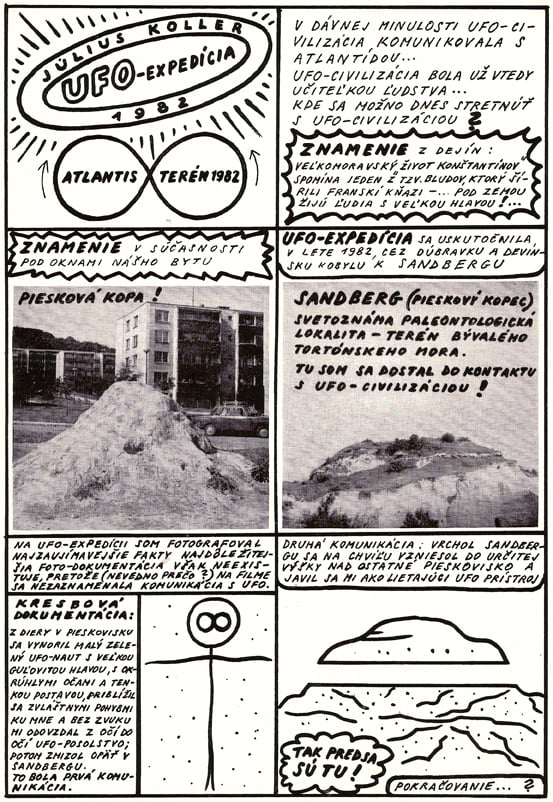
© » KADIST
Julius Koller
Drawing & Print (Drawing & Print)
Wordplay was a central focus of Koller’s work, in particular the acronym U. F. O., which he adapted in his diagrammatic drawings to stand variously for Univerzálna Futurologická Organizácia (Universal Futurological Organization, 1972–3), Univerzálny Filozoficky Ornament (Universal Philosophical Ornament, 1978) or Underground Fantastic Organization (1975), and which also appeared in a series of slapsticky self-portraits titled ‘U. F. O.–naut’ (1970–2007). These infinite variations on a common cipher constituted an insistent incantation of the Utopian principle.

© » KADIST
Julius Koller
Wordplay was a central focus of Koller’s work, in particular the acronym U. F. O, which he adapted in his diagrammatic drawings to stand variously for Univerzálna Futurologická Organizácia (Universal Futurological Organization, 1972–3), Univerzálny Filozoficky Ornament (Universal Philosophical Ornament, 1978) or Underground Fantastic Organization (1975), and which also appeared in a series of slapsticky self-portraits titled ‘U. F. O.–naut’ (1970–2007). These infinite variations on a common cipher constituted an insistent incantation of the Utopian principle.
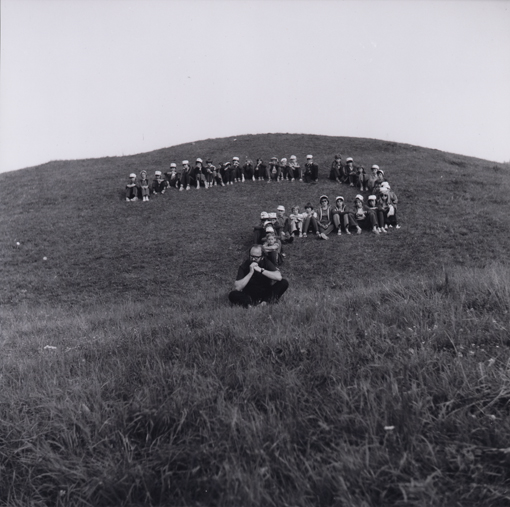
© » KADIST
Julius Koller
This work is one of Koller’s many variations which he began to use from 1970 to describe the ‘cultural situations’ he created. His “Anti-Happenings” turned mundane events into ‘cultural’ and ‘subjective’ situations. He sought to create new cultural situations that weren’t new art, but rather new ways of living: a new creativity for a new humanistic culture.
Kelly Sinnapah Mary
Kelly Sinnapah Mary is a multidisciplinary artist who’s work is informed by the diasporic journey of her ancestors...
Julius Koller
- location: Pieštany, Slovenská Republika
- year born: 1939
- gender: male
- nationality: Slovakian
Mary Reid Kelley
Drawing from literature, plays, and historical events, Mary Reid Kelley makes rambunctious videos that explore the condition of women throughout history...
Mark Grotjahn
- location: Los Angeles, California
- year born: 1968
- gender: male
- nationality: American
- home town: Pasadena, California
Mary Ann Aitken
Mary Ann Aitken was known to be very private about her art practice; she was considered somewhat of an outsider by her peers affiliated with the second wave of Detroit’s Cass Corridor arts movement...
Mary Helena Clark
Mary Helena Clark is an artist working in film, video, and installation...
Tessa Mars
Tessa Mars delves into Haitian history, her primary source of inspiration, to unveil a colourful and provocative universe that she wishes to reclaim...
Mark Soo
Born in Singapore, raised in Malaysia, and based in Canada, artist and curator Mark Soo’s practice is concept-driven and research-based...
Gary-Ross Pastrana
Gary-Ross Pastrana is an artist interested in the philosophies of art and the epistemologies of the art object...
Kelley Walker
- location: Columbus, United States
- year born: 1969
- gender: male
- nationality: American
Daniel Keller
Daniel Keller belongs to a generation of artists born at the end of the 1980s, nourished by digital imagery, who have participated in the social networks as a communication strategy, combining the public and the private spheres; a logical heir to the “entrepreneur” artist of 1990-2000...
Mark Bradford
- location: Los Angeles, California
- year born: 1961
- gender: male
- nationality: American
- home town: Los Angeles, California
Mike Kelley
- location: Los Angeles, California
- year born: 1954
- gender: male
- nationality: American
- home town: Detroit, Michigan
Marc Nagtzaam
1968, Helmond, the Netherlands...
Christoph Keller
Christoph Keller’s works function between science and art and have a practical as well as an aesthetic application...
Jeremy Deller
- location: London, United Kingdom
- year born: 1966
- gender: male
- nationality: British
Ellen Lesperance
Ellen Lesperance begins with archival footage of various activist events throughout history...
Mark Leckey
- year born: 1964
- gender: male
- nationality: British
- home town: Birkenhead, United Kingdom
Nathan Mabry
- location: Los Angeles, California
- year born: 1978
- gender: male
- nationality: American
- home town: Durango, Colorado
-
-
1970-1979
Julius Koller
1978This work is one of Koller’s many variations which he began to use from 1970 to describe the ‘cultural situations’ he created...
-
1980-1989
Julius Koller
Drawing & Print
1982(Drawing & Print) Wordplay was a central focus of Koller’s work, in particular the acronym U...
-
1990-1999
Mike Kelley
1996Towhead n’Ganga, enclosed in darkness, lorded over by the sexualized folded high priestless form reflects many of Kelley’s works, in both its compositional and semantic qualities...
-
2000-2009
Mary Ann Aitken
2002Untitled (Boom Box, Double-Sided) by Mary Ann Aitken is representational painting of a boom box on an unconventionally long canvas painted on both sides, to mimic the scale and appearance of the actual appliance...
Mark Grotjahn
Drawing & Print
2002(Drawing & Print) This particular drawing, like many of Grotjahn’s works, presents a decentered single-point perspective...
Kelley Walker
2004The triptych Black Star Press is part of the series ‘The Black Star Press project’ initiated in 2004 by the American artist Kelley Walker...
Mark Leckey
2004In Made In Heaven , we are face to face with a sculptural apparition, a divine visitation in the artist’s studio...
Christoph Keller
2007Message to the Extraterrestrials consists of a slide projector beaming images into the side of the telescope...
Mary Ann Aitken
2009Untitled (Diptych) by Mary Ann Aitken is a pair of paintings; one entirely abstract and the other a hybrid of representational and abstract elements...
-
2010-2019
Mary Reid Kelley
2010Situated in German-occupied Belgium at the end of World War I, Y ou Make Me Iliad by Mary Reid Kelley focuses on the story of two...
Mary Reid Kelley
2011In the video The Syphilis of Sisyphus (2011), Reid Kelley transported her heroine to the French demimonde...
Mark Bradford
Drawing & Print
2012(Drawing & Print) This untitled work from 2012 is a print originally made as part of the Wattis Institute for Contemporary Art’s artist limited edition series...
Jeremy Deller
2012Beyond the White Walls , with a commentary written and spoken by Jeremy Deller, is often wryly amusing...
Mary Reid Kelley
2013Priapus Agonistes by Mary Reid Kelley and Patrick Kelley is the first work in The Minotaur Trilogy (2013-2015), a trio of videos that reimagine the Greek myth of the Minotaur...
Daniel Keller
2013To make the video installation Soft Staycation (Gaze Track Edit) , the artist, playing the role of ‘job creator’, hired a group of unemployed and expat freelancers through Craigslist to watch a 30 minute compilation of national tourism ads...
Mary Helena Clark
2014The Dragon is the Frame by Mary Helena Clark is an elegy that is somewhat paradoxically organized as a film noir or murder mystery, one that pays direct homage to Hitchcock’s Vertigo ...
Marc Nagtzaam
Drawing & Print
2014(Drawing & Print) Nagtzaam’s medium is drawing and his repertory of forms varies from abstract hard-edge and wall drawing to the reproduction of written material that he collects from art magazines...
Mary Reid Kelley
2015Kelley’s 2015 portrait of the poet Charles Baudelaire is one of a series of poets, rappers, and other thinkers who have influenced the artist’s ideas about beauty, creativity, and expression...
Mary Helena Clark
2017By testing the limits of identification with the camera’s point of view, Delphi Falls cycles through multiple subjectivities...
Gary-Ross Pastrana
2018Gary-Ross Pastrana’s video installation Rewilding consists of three large-scale projections placed across the exhibition space...
-
2020-2029
Kelly Sinnapah Mary
2021Notebook 10 , l ‘enfance de sanbras (The Childhood of Sanbras) series by Kelly Sinnapah Mary is a sequel to an earlier series by the artist titled Cahier d’un non retour au pays natal (2015)...
Kelly Sinnapah Mary
2021Notebook 10 , l ‘enfance de sanbras (The Childhood of Sanbras) series by Kelly Sinnapah Mary is a sequel to an earlier series by the artist titled Cahier d’un non retour au pays natal (2015)...
Kelly Sinnapah Mary
2021Notebook 10 , l ‘enfance de sanbras (The Childhood of Sanbras) series by Kelly Sinnapah Mary is a sequel to an earlier series by the artist titled Cahier d’un non retour au pays natal (2015)...
Kelly Sinnapah Mary
2021Notebook 10 , l ‘enfance de sanbras (The Childhood of Sanbras) series by Kelly Sinnapah Mary is a sequel to an earlier series by the artist titled Cahier d’un non retour au pays natal (2015)...
Kelly Sinnapah Mary
2021Notebook 10 , l ‘enfance de sanbras (The Childhood of Sanbras) series by Kelly Sinnapah Mary is a sequel to an earlier series by the artist titled Cahier d’un non retour au pays natal (2015)...
Kelly Sinnapah Mary
2021Notebook 10 , l ‘enfance de sanbras (The Childhood of Sanbras) series by Kelly Sinnapah Mary is a sequel to an earlier series by the artist titled Cahier d’un non retour au pays natal (2015)...
Kelly Sinnapah Mary
2021Notebook 10 , l ‘enfance de sanbras (The Childhood of Sanbras) series by Kelly Sinnapah Mary is a sequel to an earlier series by the artist titled Cahier d’un non retour au pays natal (2015)...
Kelly Sinnapah Mary
2021Notebook 10 , l ‘enfance de sanbras (The Childhood of Sanbras) series by Kelly Sinnapah Mary is a sequel to an earlier series by the artist titled Cahier d’un non retour au pays natal (2015)...
Kelly Sinnapah Mary
2021Notebook 10 , l ‘enfance de sanbras (The Childhood of Sanbras) series by Kelly Sinnapah Mary is a sequel to an earlier series by the artist titled Cahier d’un non retour au pays natal (2015)...
Kelly Sinnapah Mary
2021Notebook 10 , l ‘enfance de sanbras (The Childhood of Sanbras) series by Kelly Sinnapah Mary is a sequel to an earlier series by the artist titled Cahier d’un non retour au pays natal (2015)...
Tessa Mars
2022In this untitled acrylic painting, Tessa Mars explores the long-lasting effects of colonialism on the Afro-Caribbean diaspora, particularly in terms of female vulnerability and resilience...


